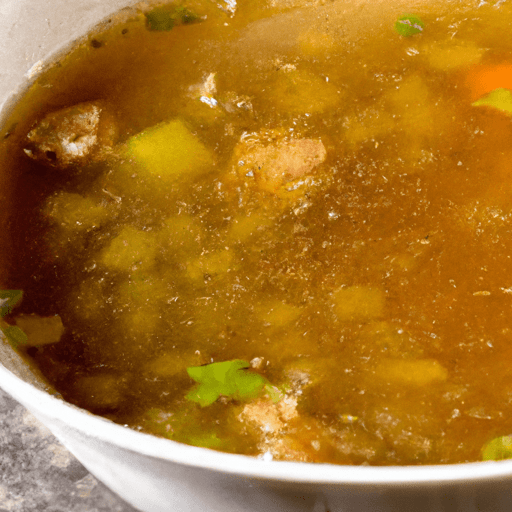Exploring the Magic of Bouillon: Enhancing Flavors in Your Culinary Adventures
Are you ready to take your culinary creations to the next level? Look no further than bouillon. This versatile ingredient is a hidden gem in the world of cooking, adding depth, richness, and complexity to a variety of dishes. Join us on a deep dive into the world of bouillon as we explore its taste, common uses in cooking, nutritional value, and even a sprinkle of interesting history.
The Taste of Bouillon: A Burst of Flavor
Bouillon is a renowned flavor booster that tickles our taste buds with its savory, umami goodness. It is commonly made by simmering meat, vegetables, herbs, and spices in water. This slow extraction process works like magic, infusing the liquid with a concentrated essence of deliciousness. The result? A flavorful elixir that adds depth and complexity to any dish.
The taste of bouillon varies depending on its base ingredients. Beef bouillon boasts a robust and meaty flavor profile, while chicken bouillon delivers a comforting and hearty taste. Vegetable bouillon offers a delicate and earthy essence, perfect for enhancing vegetarian dishes. No matter the variant you choose, bouillon adds that extra oomph that will have your taste buds dancing with each spoonful.
Common Uses: From Soups to Sensational Sauces
Bouillon is an incredibly versatile ingredient, finding its place in a wide range of culinary creations. Its primary use is undoubtedly in soups and stocks, where it acts as a flavorful foundation. Whether you’re crafting a classic chicken noodle soup or a robust beef stew, bouillon effortlessly elevates the depths of flavor, transforming a simple dish into a culinary masterpiece.
But bouillon’s talents extend far beyond the soup pot. It can also be used as a secret weapon in sauces, marinades, and gravies. A spoonful or two of bouillon can turn an ordinary pan sauce into a velvety delight. Its concentrated flavors blend seamlessly, providing that much-needed boost to your savory creations.
Nutritional Value: A Sip of Goodness
Aside from its flavor-enhancing qualities, bouillon also offers a touch of nutritional value. While the exact nutritional content varies depending on the brand and type, bouillon generally contains essential vitamins and minerals. It’s a rich source of protein, which is vital for muscle repair and growth. Additionally, bouillon can help replenish your body’s electrolytes, making it a popular choice for those recovering from illnesses or seeking a warm, comforting beverage.
However, it’s important to note that bouillon can be high in sodium. If you are watching your sodium intake, consider using low-sodium or sodium-free bouillon options, or simply adjust the amount you add to your dishes accordingly. As with any ingredient, moderation is key to a balanced diet.
A Brief History of Bouillon: Where It All Began
Believe it or not, the history of bouillon traces back to ancient times. The concept originated in ancient China, where cooks began harnessing the power of simmered bones to create nutritious broths. This practice soon spread across the globe, with variations in different cultures and cuisines. Bouillon, as we know it today, has its roots in French cuisine, where it became popular during the 18th century for its ability to extract maximum flavor from ingredients.
Fun Facts About Bouillon
- Did you know that the word “bouillon” comes from the French verb “bouillir,” which means “to boil”? It perfectly encapsulates the simmering process that gives bouillon its flavorful essence.
- Bouillon cubes were invented in the late 19th century, revolutionizing the way people prepared soups and stocks. These convenient cubes made it easy to enjoy the rich taste of bouillon without the lengthy simmering process.
- The culinary world often refers to bouillon as the “chef’s secret weapon” due to its ability to amplify flavors and transform ordinary dishes into extraordinary ones.
Conclusion
Whether you’re a seasoned chef or a passionate home cook, bouillon holds a special place in the hearts and kitchens of culinary enthusiasts worldwide. Its ability to elevate flavors, add depth to recipes, and provide a comforting warmth makes bouillon an indispensable ingredient. So why not embark on a flavor-filled adventure and bring the magic of bouillon into your next culinary masterpiece? Get ready to savor the delightful notes, enhance your dishes, and take your cooking to new heights. Happy cooking!
Origin
- Bouillon is a clear, flavorful stock or broth typically made by simmering meat, poultry, bones, or vegetables in water with herbs and spices.
- The word “bouillon” is derived from the French word for “boiling” or “broth.”
Common Uses
- Bouillon is often used as a base for soups, stews, sauces, and gravies.
- It can also be used as a hot beverage on its own, similar to consommé.
Nutritional Benefits
- Bouillon can be a good source of vitamins, minerals, and amino acids.
- The nutritional content depends on the ingredients used to make the bouillon.
Unique Properties and Historical Significance
- In addition to its culinary uses, bouillon has been used for medicinal purposes for centuries.
- Bouillon cubes, a convenient and portable form of bouillon, were invented by Swiss chemist Julius Maggi in the late 19th century.
- Bouillon cubes gained popularity worldwide as an easy way to enhance the flavor of soups and dishes.
- Different cultures have their own variations of bouillon, such as Chinese chicken bouillon, Mexican beef bouillon (caldo de res), and Vietnamese pho broth.
- Vegetarian and vegan bouillons made from plant-based ingredients have become increasingly popular as alternatives to traditional meat-based bouillons.




Use the share button below if you liked it.
It makes me smile, when I see it.